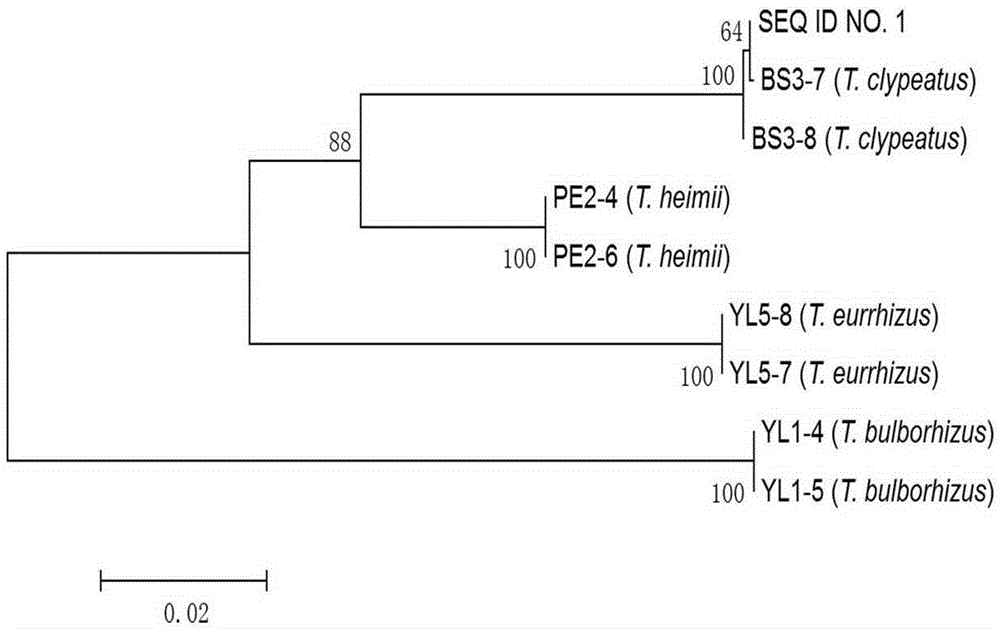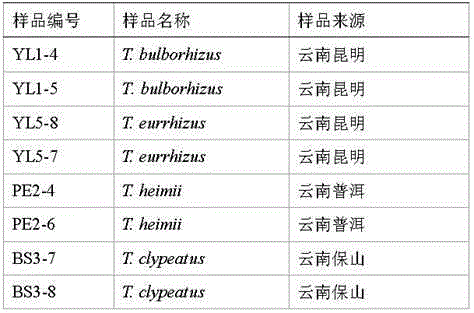DNA (deoxyribonucleic acid) barcode reference gene of termitomyces clypeatus and application of DNA barcode reference gene of termitomyces clypeatus
A standard gene, the technology of Gallus firsum, applied in application, genetic engineering, plant genetic improvement, etc., can solve the problems of less habitat environment, human factors, over-harvesting, etc., and achieve low integrity requirements and improve identification efficiency , the effect of easy comparison
- Summary
- Abstract
- Description
- Claims
- Application Information
AI Technical Summary
Problems solved by technology
Method used
Image
Examples
Embodiment 1
[0030] Embodiment 1: sample to be tested and pointed shield termite umbrella ( Termitomycesclypeatus) Homology identification of DNA barcode identification standard gene fragments
[0031] 1. Collection of Gallinarum albumen specimens: 8 samples were collected from Kunming, Pu'er and other places in Yunnan Province. Fresh fruiting bodies were directly cut out of tissue or dried with silica gel for later use. See Table 1 for sample and source details.
[0032] Table 1 Sample and source information
[0033]
[0034] 2. Extraction of Genomic DNA from Gallus pilosulae: using the improved CTAB method or using BiomigaEZgene TM Genomic DNA was extracted with the FungalgDNA MiniprepKit kit, and the DNA concentration of the sample was diluted to 0.5 μg / μl with sterilized deionized water.
[0035] 3. Amplify the DNA fragment and carry out polymerase chain reaction (PCR), that is, amplify with specific primers. The primer pair sequence is forward primer RPB2B-f: 5'-CCGCAAAGGCTGGTGT...
Embodiment 2
[0038] Embodiment 2: Using the phylogenetic tree method to set up identification rules to identify species
[0039] Using the steps described in Example 1 to obtain the sequence of the sample to be tested, the standard gene sequence and the sample sequence to be identified were combined and MEGA was used to repeat 1000 times to construct a phylogenetic tree based on the Kimura-2-parameter model. The sample to be tested (BS3-7 and BS3-8) DNA barcode sequences clustered with standard gene sequences, with T. bulborhizus, T. eurrhizus and T. heimii The sequences showed obvious divergence, indicating that the sample to be identified could be identified as the termite ( Termitomycesclypeatus ).
[0040] Compared with the traditional morphological identification method, the gene sequence obtained and the method used in the present invention are beneficial to realize the rapid and accurate identification of the Gallus albuminosa.
PUM
 Login to View More
Login to View More Abstract
Description
Claims
Application Information
 Login to View More
Login to View More - R&D
- Intellectual Property
- Life Sciences
- Materials
- Tech Scout
- Unparalleled Data Quality
- Higher Quality Content
- 60% Fewer Hallucinations
Browse by: Latest US Patents, China's latest patents, Technical Efficacy Thesaurus, Application Domain, Technology Topic, Popular Technical Reports.
© 2025 PatSnap. All rights reserved.Legal|Privacy policy|Modern Slavery Act Transparency Statement|Sitemap|About US| Contact US: help@patsnap.com


